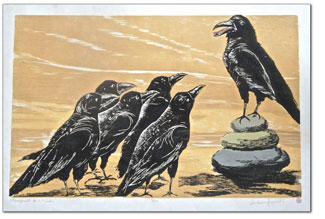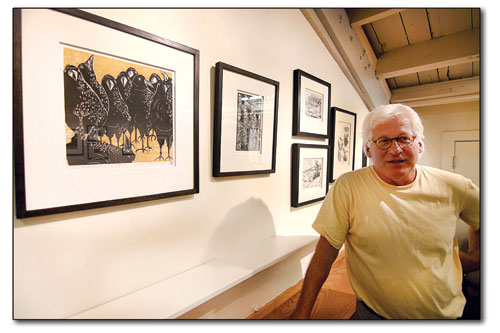|
|
Carving a niche
DAC Art Library features exquisite work of Michigan printmaker
The Art Library at the Durango Arts Center is an ideal venue for an intimate art-viewing experience. And now through Oct. 31, art lovers have a chance to get up close and personal with the work of highly skilled Michigan printmaker Andrew Jagniecki. If the name sounds familiar, he is the father of DAC Marketing Director Elsa Jagniecki. His work has most recently been seen at Studio & as well as in previous DAC shows. This, however, is his first solo show in Durango, and it is a chance for Durangoans to see almost 20 of his pieces.
JusttheFactsWhat: “Earth, Water, Sky,” printmaking by Andrew Jagniecki |
Jagniecki attended Grand Valley State University in western Michigan, where he was a student of Japanese master printmaker Takeshi Takahara. After graduating, he went on to make a career as a professional artist and over the last 40 years has exhibited widely in Michigan, New York, Pennsylvania and as far away as Kyoto, Japan.
The show is put on by Friends of the Art Library (F.O.A.L.), which is comprised of local artists who often work in the same mediums exhibited and are personally familiar with many of the artists shown. F.O.A.L. curates six paper, printmaking and fiber-arts exhibits per year in the cozy upstairs space.
One of the oldest forms of artistic expression, printmaking is the process of engraving an image onto a surface. The Sumerians were believed to be the first to cut designs into stone, a thousand years before the birth of Christ. Likewise, the Chinese created a rudimentary form of print around the second century A.D. Late eighth-century Japanese artisans produced the first wood-block rubbings, but it wasn’t until the early 1400s, in Germany, that woodcuts were transferred onto paper. The intentional making of reproductions as an art form, however, didn’t take hold until the 1800s, and it was the first time multiple images of an artist’s “original” work became available.
Although Jagniecki has a style of his own, there are influences of printmakers such as Leonard Baskin (1922-2000) and Jagniecki’s graduate professor, Maurico Lasansky, (1914-2012), evident in his work. The themes Jagniecki gravitates toward are diverse but often include landscape, wildlife and most recently, crows.
Other artists that have inspired him, in addition to those mentioned above, are Vincent van Gogh and 20th century American abstract painter Mark Rothko. In fact, there are some obvious van Gogh affects in Jagniecki’s treatment of celestial shapes and ripples, ala “Starry Night.”
 “Prerequisite to Murder,” one of Andrew Jagniecki’s colorful prints that will be on display at the Arts Center Library through Oct. 31./Courtesy photo |
When portraying landscapes, Jagniecki’s prints possess a delicateness and subtlety of color that are charming and thought provoking. His aforementioned crows, he admits, are a new favorite. The typically rambunctious birds in his prints have an almost humorous quality and often look as if they are about to speak.
Those familiar with printmaking processes – particularly woodcut, engraving and linocut – understand the difficulty of aligning multiple colors, and Jagniecki’s treatment is masterful. He demonstrates a control of the medium as well as an understanding of light and how it sets the mood in a scene.
To achieve multiple colors, Jagniecki must use several separate “plates” made from wood or metal on which the image is carved – a laborious and time-intensive process. “Each color location is eventually carved away on the plate,” he explains, “(and) then the next color is created or ‘pulled,’ as it is termed, and so on, until all colors are printed.”
Jagniecki is also quite proficient in the complicated technique of color-reduction, in which all colors are done on one plate.
One of the woodcuts in the show, “Mid-West Wind Farm,” in particular reflects his total grasp of the process. The small (5.5”x11”), colorful print depicts several rows of farm land with a barn on the horizon and wind turbines in the background. The blue sky is expansive, with a large cloud formed from the negative space hovering above the scene. Its perspective creates a great sense of space.
Another emotive image in the show is a serene but desolate landscape titled “Winter Shadows.” It gives viewers a chance to study a color-reduction linocut. The subtlety of color, light and shadow draw the viewer into the frame and suggest a quiet, late afternoon sunset in the throes of a long winter.
Of the crow images, “Prerequisite to Murder” and “A Murder of Crows” are whimsical narratives that impart human-like qualities to a group (technically called a “murder”) of what appears to be talking crows. Although the crow prints are stand-alone pieces, they could easily be illustrations for a sophisticated children’s book.
Jagniecki’s passion for his work is also evident in the hand-made wooden frames he fabricated for the pieces in the show. Using oak and cherry, he treats them with apple vinegar-soaked steel wool, finishes them with lap joints at the corners and oils them to give a black anodized appearance. All this lends a dramatic enhancement to the art.
This exhibit is one of many in a long line of successful shows at the Art Library and definitely worth climbing the stairs to see and enjoy.
In this week's issue...
- January 25, 2024
- Bagging it
State plastic bag ban is in full effect, but enforcement varies
- January 26, 2024
- Paper chase
The Sneer is back – and no we’re not talking about Billy Idol’s comeback tour.
- January 11, 2024
- High and dry
New state climate report projects continued warming, declining streamflows

